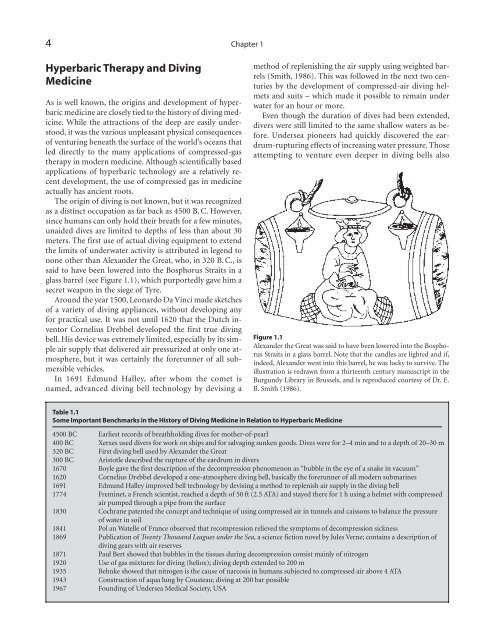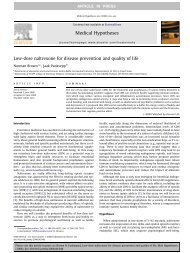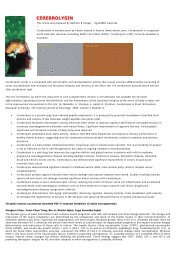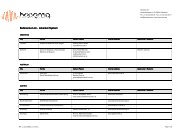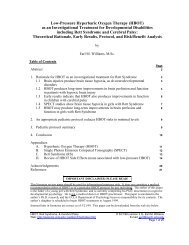Textbook of Hyperbaric Medicine - HyperMED
Textbook of Hyperbaric Medicine - HyperMED
Textbook of Hyperbaric Medicine - HyperMED
You also want an ePaper? Increase the reach of your titles
YUMPU automatically turns print PDFs into web optimized ePapers that Google loves.
4 Chapter 1<br />
<strong>Hyperbaric</strong> Therapy and Diving<br />
<strong>Medicine</strong><br />
As is well known, the origins and development <strong>of</strong> hyperbaric<br />
medicine are closely tied to the history <strong>of</strong> diving medicine.<br />
While the attractions <strong>of</strong> the deep are easily understood,<br />
it was the various unpleasant physical consequences<br />
<strong>of</strong> venturing beneath the surface <strong>of</strong> the world’s oceans that<br />
led directly to the many applications <strong>of</strong> compressed-gas<br />
therapy in modern medicine. Although scientifically based<br />
applications <strong>of</strong> hyperbaric technology are a relatively recent<br />
development, the use <strong>of</strong> compressed gas in medicine<br />
actually has ancient roots.<br />
The origin <strong>of</strong> diving is not known, but it was recognized<br />
as a distinct occupation as far back as 4500 B. C. However,<br />
since humans can only hold their breath for a few minutes,<br />
unaided dives are limited to depths <strong>of</strong> less than about 30<br />
meters. The first use <strong>of</strong> actual diving equipment to extend<br />
the limits <strong>of</strong> underwater activity is attributed in legend to<br />
none other than Alexander the Great, who, in 320 B. C., is<br />
said to have been lowered into the Bosphorus Straits in a<br />
glass barrel (see Figure 1.1), which purportedly gave him a<br />
secret weapon in the siege <strong>of</strong> Tyre.<br />
Around the year 1500, Leonardo Da Vinci made sketches<br />
<strong>of</strong> a variety <strong>of</strong> diving appliances, without developing any<br />
for practical use. It was not until 1620 that the Dutch inventor<br />
Cornelius Drebbel developed the first true diving<br />
bell. His device was extremely limited, especially by its simple<br />
air supply that delivered air pressurized at only one atmosphere,<br />
but it was certainly the forerunner <strong>of</strong> all submersible<br />
vehicles.<br />
In 1691 Edmund Halley, after whom the comet is<br />
named, advanced diving bell technology by devising a<br />
method <strong>of</strong> replenishing the air supply using weighted barrels<br />
(Smith, 1986). This was followed in the next two centuries<br />
by the development <strong>of</strong> compressed-air diving helmets<br />
and suits – which made it possible to remain under<br />
water for an hour or more.<br />
Even though the duration <strong>of</strong> dives had been extended,<br />
divers were still limited to the same shallow waters as before.<br />
Undersea pioneers had quickly discovered the eardrum-rupturing<br />
effects <strong>of</strong> increasing water pressure. Those<br />
attempting to venture even deeper in diving bells also<br />
Figure 1.1<br />
Alexander the Great was said to have been lowered into the Bosphorus<br />
Straits in a glass barrel. Note that the candles are lighted and if,<br />
indeed, Alexander went into this barrel, he was lucky to survive. The<br />
illustration is redrawn from a thirteenth century manuscript in the<br />
Burgundy Library in Brussels, and is reproduced courtesy <strong>of</strong> Dr. E.<br />
B. Smith (1986).<br />
Table 1.1<br />
Some Important Benchmarks in the History <strong>of</strong> Diving <strong>Medicine</strong> in Relation to <strong>Hyperbaric</strong> <strong>Medicine</strong><br />
4500 BC Earliest records <strong>of</strong> breathholding dives for mother-<strong>of</strong>-pearl<br />
400 BC Xerxes used divers for work on ships and for salvaging sunken goods. Dives were for 2–4 min and to a depth <strong>of</strong> 20–30 m<br />
320 BC First diving bell used by Alexander the Great<br />
300 BC Aristotle described the rupture <strong>of</strong> the eardrum in divers<br />
1670 Boyle gave the first description <strong>of</strong> the decompression phenomenon as “bubble in the eye <strong>of</strong> a snake in vacuum”<br />
1620 Cornelius Drebbel developed a one-atmosphere diving bell, basically the forerunner <strong>of</strong> all modern submarines<br />
1691 Edmund Halley improved bell technology by devising a method to replenish air supply in the diving bell<br />
1774 Freminet, a French scientist, reached a depth <strong>of</strong> 50 ft (2.5 ATA) and stayed there for 1 h using a helmet with compressed<br />
air pumped through a pipe from the surface<br />
1830 Cochrane patented the concept and technique <strong>of</strong> using compressed air in tunnels and caissons to balance the pressure<br />
<strong>of</strong> water in soil<br />
1841 Pol an Watelle <strong>of</strong> France observed that recompression relieved the symptoms <strong>of</strong> decompression sickness<br />
1869 Publication <strong>of</strong> Twenty Thousand Leagues under the Sea, a science fiction novel by Jules Verne; contains a description <strong>of</strong><br />
diving gears with air reserves<br />
1871 Paul Bert showed that bubbles in the tissues during decompression consist mainly <strong>of</strong> nitrogen<br />
1920 Use <strong>of</strong> gas mixtures for diving (heliox); diving depth extended to 200 m<br />
1935 Behnke showed that nitrogen is the cause <strong>of</strong> narcosis in humans subjected to compressed air above 4 ATA<br />
1943 Construction <strong>of</strong> aqua lung by Cousteau; diving at 200 bar possible<br />
1967 Founding <strong>of</strong> Undersea Medical Society, USA


